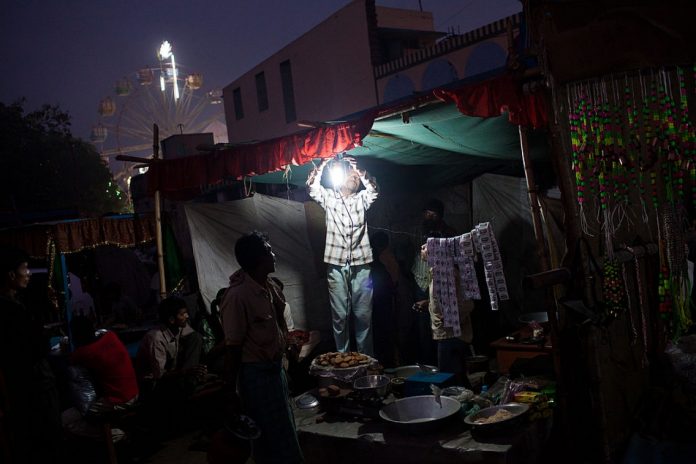Snapshot
- Notwithstanding results of highly limited and contextualised studies, India should take a source-agnostic view when it comes to filling gaps in electrification.
When the Narendra Modi government came to power, nearly 18,500 villages languished in darkness, untouched by electricity 134 years after Thomas Alva Edison started his first electricity distribution vendor and 67 years after India’s independence. The absence of this most ubiquitous resource, which city-dwellers take for granted, has over the years exacerbated the problems of illiteracy, disease, personal safety, and sheer destitution amongst the millions of inhabitants of the neglected villages.
Equitable access to resources has been a common theme for the various governmental initiatives over the last three years. With power, it started with the Prime Minister pledging from the ramparts of the Lal Qila in his 2015 Independence Day address that all of the remaining 18,452 villages would be electrified within 1,000 days. As of March 2017, ahead of the schedule, over three-fourths of this target has been met, and the complete electrification of all villages is on track to meet the 1,000-day deadline.
One of the key methods for electrification for some of these villages is off-grid solar. This involves providing small solar units for a village to light up common areas and households which are interested. Some of these villages are situated in extremely remote and hilly regions, and electrification by the grid isn’t logistically or economically feasible.
Most of these villages are located in the Northeastern states, deserts of Rajasthan, or in the Left wing extremism-hit districts in eastern India. Over 2,700 villages in the country are being electrified using this method.
Recently, a study titled Does basic energy access generate socioeconomic benefits? A field experiment with off-grid solar power in India was published in a journal Science Advances, authored by academics from universities in the United States of America and United Kingdom.
The paper details result of a year-long study conducted in villages of Barabanki district, Uttar Pradesh. The study was conducted between February 2014 and July 2015 to explore the impact of off-grid solar power on 1,281 rural households dividing them between groups using and not using off-grid solar power.
This project was supported by a rural solar power provider, Mera Gao Power (MGP). The study focused on 81 randomly chosen un-electrified habitats, dividing them between treatment (with the microgrids) and control (no microgrids) habitats.
Of the treatment group of 50 habitats, 21 adopted the microgrids. 117 households adopted the MGP service at some point in time during the study. MGP charged a nominal fee of Rs 100 per month for the facility, providing two light-emitting diodes (LEDs) and one mobile charging point against the microgrid. The power was provided to houses within 100 metres of a central pucca house in these villages. MGP provides electricity after 7 pm, the peak energy demand time – when families are together.
Based on these statistics, it is quite clear that the study had the following characteristics:
a. Localised to a couple of blocks in Barabanki
b. Dependent on MGP rules, business model, and efficiency
c. Focused on participating households, not necessarily the most backwards or needy ones
d. Limited by physical location of households
e. Covering a short duration of power availability at the hours which are usually dinner hours for families.
The study has brought out several conclusions. The notable positive conclusion was increased availability of power and savings from the amount spent on kerosene. The study also found no positive impact of off-grid solar power on socio-economic upliftment. Information on socio-economic variables such as savings, household expenditures, household business creation, time spent in productive work by women, use of lighting for study, etc., was collected before and during the period of the study.
Even though the paper cites several other similar studies – most importantly one conducted in Rwanda – that establish an inseparable causal link between off-grid solar electrification and socio-economic upliftment, it notes no improvement in socio-economic indicators in this case in Barabanki. The authors do note that “our findings do not imply that larger systems for generating off-grid solar power cannot produce broader socio-economic benefits.”
Agency and media reports in Indian outlets, however, extrapolated this study limited in time, access, capacity, and spread to infer that off-grid solar was irrelevant in its entirety.
The comments on no socio-economic upliftment have been differentially played up without accounting for the limiting study parameters. In fact, some of the conclusions were unexceptionable – if there is extra power for the dinner time, that’s not likely to increase female participation in employment.
Or if the extra power is available at the time when families are in their homes, there isn’t likely to be any extra sense of physical safety for women.
In contrast, the off-grid solar power access being provided by the government under the various rural electrification initiatives is far greater than what has been provided by the private company involved in this study.
For instance, the government’s off-grid solar kit will, in addition to LEDs and mobile charging points, provide households with fans and charging points for other appliances. Moreover, the government programs are targeting 24/7 constant and affordable supply of power, not conveniently chosen 1-hour evening power availability.
Even with the minimal access which the study is based on, the benefits are clear. There is an improvement in lighting as well as the reduction in usage of kerosene, which will improve the health of people and reduce subsidy burden.
Even for this limited positive impact, it would take more than a year to see perceptible improvements in lives of people – for instance, better health leading to reduced medical expenses over time.
With much greater access to off-grid solar power that is being guaranteed by the government, irreversible socio-economic benefits will accrue to the remotest regions of India.
Electrification is, of course, a necessary condition for such benefits, but the local governments have to ensure a lot more – access to physical infrastructures like roads, jobs, and financial access to tie in all the pieces together.
India’s size and the terrain is a big challenge for any infrastructure provision, and 100 per cent electrification is no exception.
However, precisely because of these geographical complexities, India should take a source-agnostic view when it comes to filling gaps in electrification, as long as the cost is not a constraining factor.
Solar micro-grids are and should remain, an essential intermediate step in the provision of power supplies to remote villages.
India should take substantial, incremental steps forward, rather than waiting for ad infinitum on the sidelines to take that one big leap. Solar micro-grids are good for the immediate purpose, and let great not be the enemy of good.









